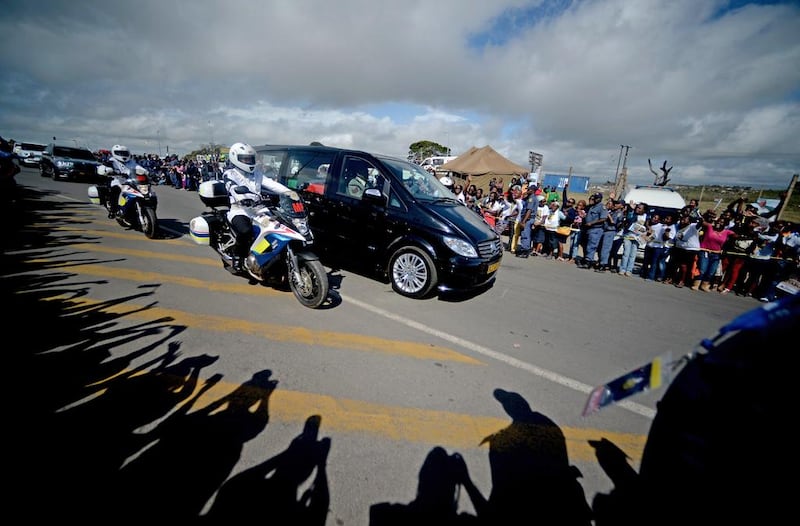South Africa's Eastern Cape is predominately a pastoral place, a land of fiery sunrises, lonely huts and green patchwork hills on which herds of cattle seem to glide.
It is here where Nelson Mandela, nearly a century ago, was born and where he herded cows in his youth before travelling to the big city.
It is here where South Africa's finest son will be laid to rest today.
In Port Elizabeth, the biggest city in the Eastern Cape, the motorway, university and football stadium are all named after Mandela. Mandela's legacy is so ubiquitous here and across South Africa that many towns and cities have a Nelson Mandela Road. His smiling portrait, eyes twinkling, is even emblazoned on bank notes, so-called "Randelas".
It was not always so. In the late 1980s and early 1990s, when I was growing up in a seemingly idyllic white middle-class neighbourhood, Mandela's name was rarely spoken, and when it was it was usually in the pejorative. Pictures of Mandela were rare, apartheid press censorship was draconian, and at the time he seemed to many whites to be a mysterious villain who dabbled in all manner of nasty business - communism, terrorism, or worse.
I recall hearing racist jokes about Mandela, not only told by adults but also by children at school.
Since Mandela's death in his Johannesburg home on December 5, many have asked what Mandela's death means for my country and the answers may, in part, lie in answering how Mandela won over a sceptical and fearful white South Africa.
When he was released from jail in 1990 I had just started primary school and although I was not fully aware of the political machinations, I knew I was living through an era of radical change. Black children were allowed to attend former white-only schools, a change that most white children thought to be completely normal, despite the fears of some parents and the misplaced racist jokes told by some children, who perhaps did not know any better at the time.
For me, being around black people was no big deal as a black woman, Florah Kula, had helped my parents raise me. It was common for middle-class white families to hire blacks to look after their children.
The post-apartheid mythology around South Africa's transition between 1990 and 1994 has it that the change was miraculous and peaceful. It was a fraught period in which thousands of people were killed in political violence, especially in the black townships near Johannesburg and Durban, but largely peaceful in much of the country.
By 1992 I had become more aware of the upheaval in the country and news bulletins covered places such as Katlehong and Boipotang where people were being massacred.
Then in 1993, Chris Hani, a key figure in the ANC's armed wing, was assassinated by white right wingers in 1993, a killing that had the potential to derail negotiations towards democracy and exacerbate the violence. It was Mandela who appeared on national television, wearing spectacles and looking as solemn as he did studious. He called for peace and to everyone watching he looked presidential, his words were presidential and for many whites this was a momentous occasion: at that moment he proved he could be a president for all.
"Tonight I am reaching out to every single South African, black and white, from the very depths of my being," Mandela said. "Now is the time for all South Africans to stand together against those who, from any quarter, wish to destroy what Chris Hani gave his life for - the freedom of all of us."
One year later Mandela was president. My president. Our president. A year after that South Africa hosted and won the Rugby World Cup. I still heard racist jokes in the new South Africa but Mandela was never the target.
He was the paragon of morality. A man of integrity. A man of trust. But he was one among many courageous men - and women - who sacrificed their lives to overthrow the tyranny of white minority rule.
Mandela's death should remind us to remember other South Africans who sacrificed their lives for the struggle against apartheid. What of Steve Biko, the architect of the Black Consciousness Movement, a liberation philosophy that imbued black people with pride in being black and created the conditions of fire and brimstone for the youth uprisings of the 1970s?
No stadium is named after Biko and his face adorns no South African currency. Although he did not live to see the end of apartheid, his legacy is alive through the ideals for which he fought that are now manifest in the new South Africa.
In the same way Mandela's message of reconciliation will echo in the months, years and decades to come. Fears that his death would herald the start of a "race-based civil war" was something imagined by the right-wing media, especially in the UK. After all, Mandela had made only limited public appearances since 2004 and the country has not torn itself apart.
Yet there are reckonings to come. Economic apartheid is entrenched, crime and HIV-Aids are rife, and Jacob Zuma's government has been hobbled by a series of corruption scandals.
In the beautiful Eastern Cape, the lands that produced Mandela, Hani, Biko and Florah, one in three people is now unemployed. Florah's children have had fewer opportunities than me because I am white and they are black.
Mandela's work is not yet done.
rferraris@thenational.ae
Richard Ferraris is an assistant foreign editor
-----------------
The National's assistant foreign editor Richard Ferraris talks to Chitrabhanu Kadalayil, a sports page/web editor at the paper, on how Nelson Mandela used sports to unite a racially divided South Africa.
Podcast





